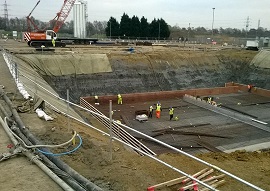Ground
The term ‘ground’ typically refers to the solid surface of the Earth or an area that is used for a specified purpose.
It can also be used to refer to the storey of a building that is on the ground, i.e. ‘ground level’ or ‘ground floor’.
In terms of the physical matter of the ground, it is made up of different layers. Topsoil is the first, upper layer of soil, typically measuring between 5 - 20 cm (2 - 8 inches) deep. It can also be measured as the depth from the surface level to the subsoil, i.e. the distance to the first densely-packed layer of soil. Subsoil is the layer (or stratum) of soil immediately underneath the surface topsoil. Beneath the subsoil is the substratum - a layer of residual bedrock, sediments or deposits.
The ‘water table’ is the below-ground level that marks the transition between ground that is saturated with water and ground that is not saturated. The upper, unsaturated level, is known as the 'capillary fringe' or 'zone of aeration'.
In terms of construction, ‘groundworks’ refers to work done to prepare sub-surfaces for the start of construction work. Aside from any demolition or site enabling works that may need to be carried out, groundworks are usually the first stage of a construction project.
Ground investigations are a means of determining the condition of the ground, ideally before beginning construction works. They focus specifically on intrusive geotechnical work such as trial pits and boreholes. An assessment of ground conditions typically includes geology, hydrology, hydrogeology and soil conditions of a site and surrounding, along with any contaminated land.
There are a number of ground improvement or ground modification techniques that can be used to stabilise or improve the condition of an area of ground before construction work takes place. This may be necessary to improve or modify the ground shear strength, stiffness, permeability, and so on.
Designing Buildings Wiki has a number of articles relating to the ground, including:
- Alluvium.
- Bearing capacity.
- Building foundations.
- Clay.
- Contaminated land.
- Ecological survey.
- Excavation.
- Geophysical survey.
- Ground anchor.
- Ground conditions.
- Ground energy options.
- Ground heave.
- Ground improvement techniques.
- Ground level.
- Ground-penetrating radar.
- Ground source heat pumps.
- Ground storey.
- Groundworks.
- In situ testing of soils.
- Land surveying.
- Methane and other gasses from the ground.
- Minerals surveyor.
- Road construction.
- Settlement.
- Sinkholes.
- Soil report.
- Soil survey.
- Subsidence.
- Subsoil.
- The importance of soil analysis.
- Topsoil.
- Types of soil.
- Underpinning.
- Underreaming.
- Vibro-compaction.
- Water table.
[edit] Related articles on Designing Buildings Wiki
Featured articles and news
Government consultations for the summer of 2025
A year of Labour, past and present consultations on the environment, the built environment, training and tax.
CMA competitiveness probe of major housing developers
100 million affordable housing contributions committed with further consultation published.
Homes England supports Greencore Homes
42 new build affordable sustainable homes in Oxfordshire.
Zero carbon social housing: unlocking brownfield potential
Seven ZEDpod strategies for brownfield housing success.
CIOB report; a blueprint for SDGs and the built environment
Pairing the Sustainable Development Goals with projects.
Types, tests, standards and fires relating to external cladding
Brief descriptions with an extensive list of fires for review.
Latest Build UK Building Safety Regime explainer published
Key elements in one short, now updated document.
UKGBC launch the UK Climate Resilience Roadmap
First guidance of its kind on direct climate impacts for the built environment and how it can adapt.
CLC Health, Safety and Wellbeing Strategy 2025
Launched by the Minister for Industry to look at fatalities on site, improving mental health and other issues.
One of the most impressive Victorian architects. Book review.
Common Assessment Standard now with building safety
New CAS update now includes mandatory building safety questions.
RTPI leader to become new CIOB Chief Executive Officer
Dr Victoria Hills MRTPI, FICE to take over after Caroline Gumble’s departure.
Social and affordable housing, a long term plan for delivery
The “Delivering a Decade of Renewal for Social and Affordable Housing” strategy sets out future path.
A change to adoptive architecture
Effects of global weather warming on architectural detailing, material choice and human interaction.
The proposed publicly owned and backed subsidiary of Homes England, to facilitate new homes.
How big is the problem and what can we do to mitigate the effects?
Overheating guidance and tools for building designers
A number of cool guides to help with the heat.
The UK's Modern Industrial Strategy: A 10 year plan
Previous consultation criticism, current key elements and general support with some persisting reservations.
Building Safety Regulator reforms
New roles, new staff and a new fast track service pave the way for a single construction regulator.

























